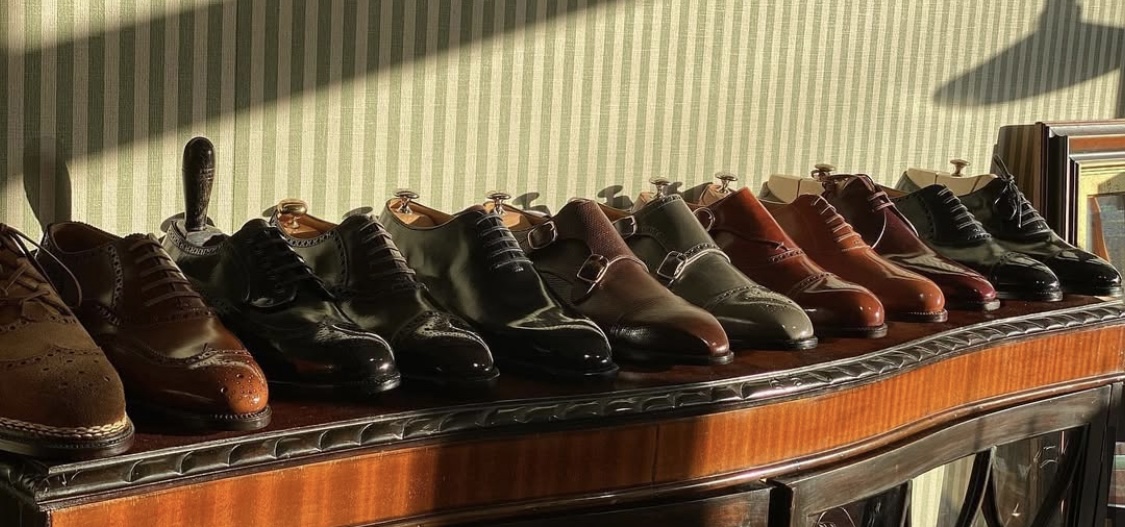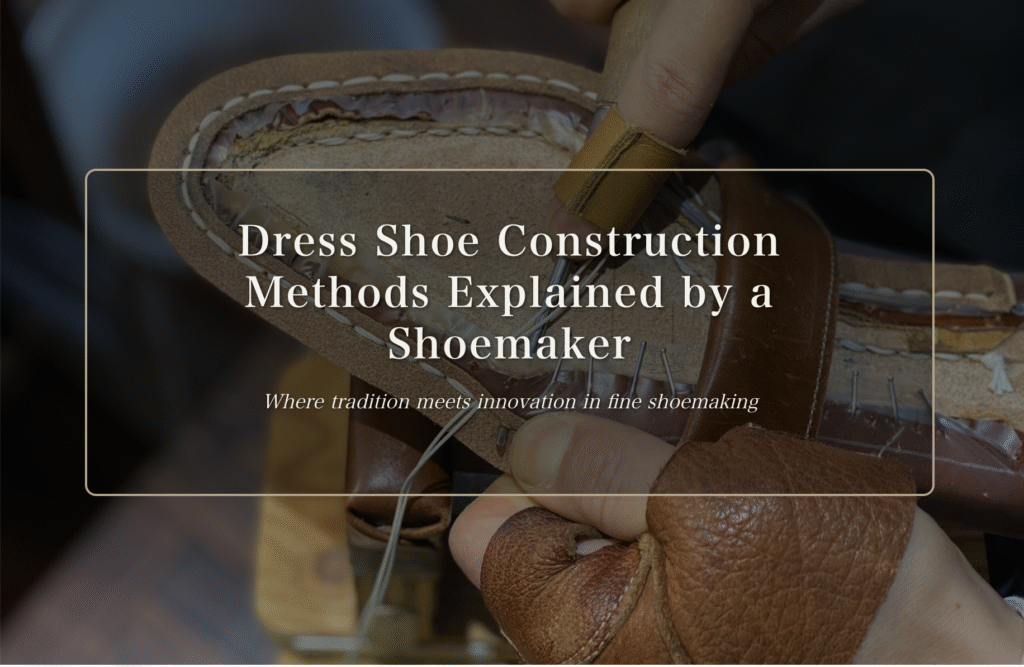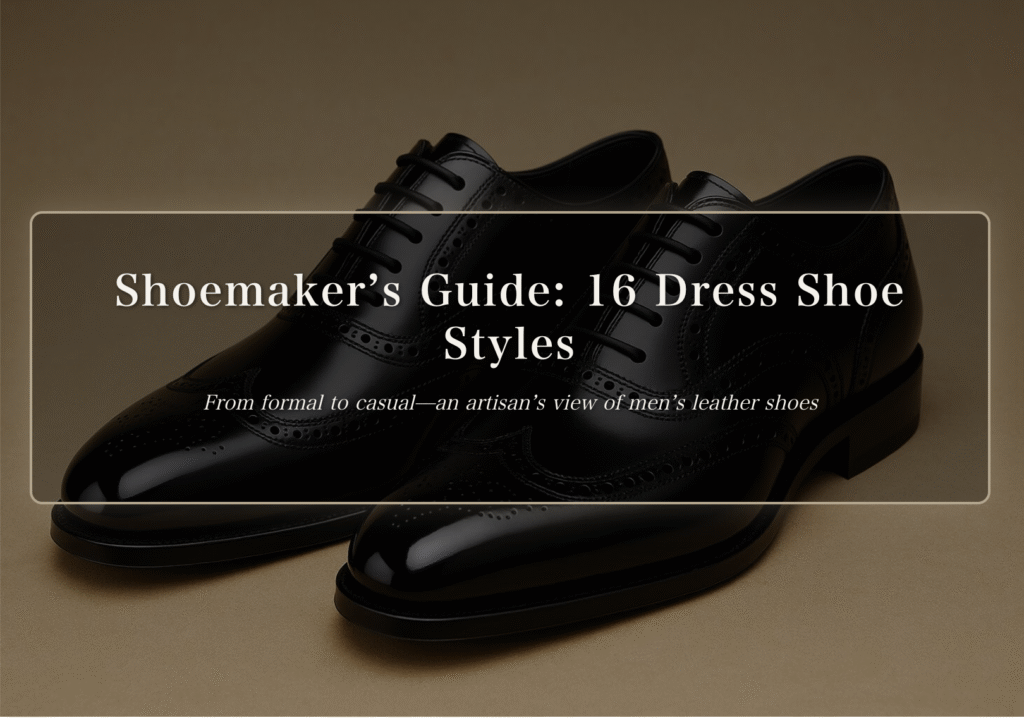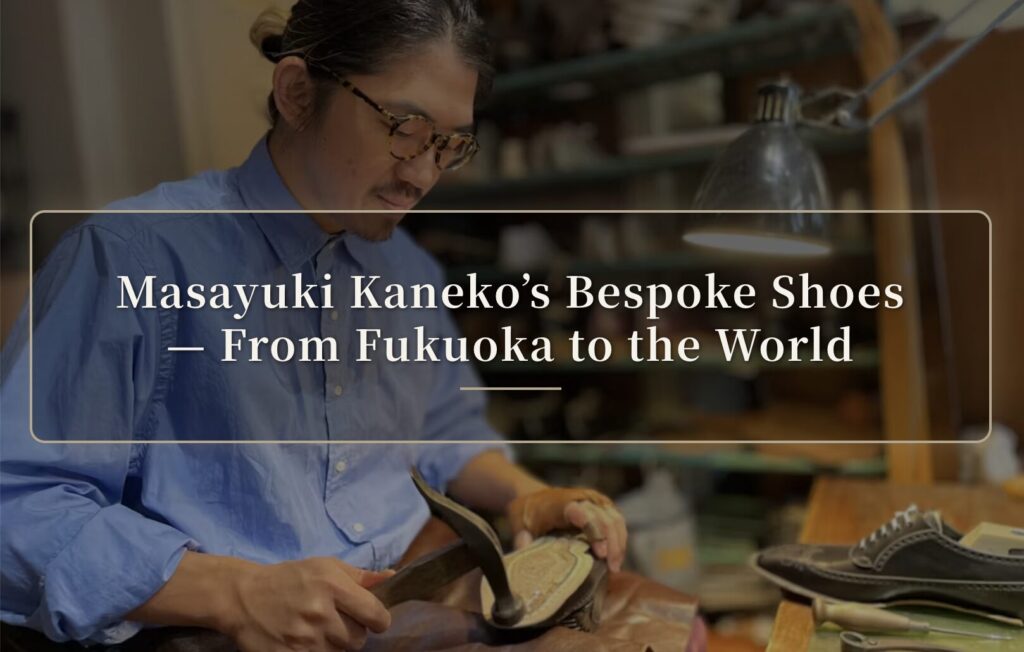Published: |
Updated: |
Author: Masayuki Kaneko
Dress shoe design distills millennia of human ingenuity and taste. From a shoemaker’s perspective, this guide explores that deep world of design.
The essence of shoe design and its modern meaning
Dress shoe design is not mere decoration or trend. It’s a synthesis of function and beauty at a high level—a crystallization of human wisdom. As shoemakers, we create footwear that protects the foot, supports gait, and lives alongside its wearer as a true tool.
Today, the significance of dress shoe design is deeper than ever. In an era of mass production, handmade shoes transcend “just footwear.” They express craft skill and sensibility and reflect the wearer’s personality and values. Japan’s refined aesthetics meet the European shoemaking tradition to produce distinctive designs with global appeal.
To grasp the essence of design, start with function: the last shaped to your foot, sole architecture that absorbs impact, and materials that stand up to long wear. Beauty sits atop function—ornament that ignores function is not true design.
Design also carries cultural memory: the poised look of the Oxford, the countryside charm of brogues, the urban ease of loafers. Each design has a history and social meaning. Modern makers inherit these classics yet adapt them to contemporary lifestyles.
Criteria for choosing a design: a shoemaker’s view
Above all, I value harmony—not only visual appeal but alignment with body type, gait, lifestyle, and values. Great dress shoe design integrates these factors so the choice feels natural and right for the wearer.
First consider use. Business calls for reliability and poise; casual settings reward comfort and approachability; formal occasions demand ceremony and restraint. Understanding the context helps a maker select the right design elements.
Fit characteristics matter too: foot width, instep height, arch, and gait habits. High insteps often prefer open-laced Derby shoes; narrow feet frequently suit closed-laced Oxfords. A beautiful shoe that ignores these traits won’t satisfy in the long run.
Think long term: designs with timeless beauty, age-appropriate elegance, and serviceable construction that welcomes repair. Balance budget with expected longevity to arrive at a wise, craftsmanlike choice.
And weigh price–quality balance. Expensive shoes often use finer materials and processes, but the “best” pair is the one matched to your frequency of wear, environment, and care habits.
Historical evolution of shoe design
To understand modern dress shoe design, knowing the long arc of footwear helps. The oldest known footwear remnants date to around 7000–8000 BCE—plant-fiber sandal fragments from caves in Georgia. The world’s oldest leather shoe, from about 3500 BCE, was found in an Armenian cave, underscoring how deeply shoes are woven into human life.
In the ancient world, design reflected climate and status. In Mesopotamia and Egypt, simple papyrus or palm sandals suited the heat; among the wealthy, sandals became status symbols, richly colored and jeweled. From the start, footwear signified more than utility.
Greece developed specialized footwear like the thick-soled kothornos for theater. Rome adopted and adapted: citizens wore shoes and sandals such as the calceus, and legionaries laced up rugged caligae. Shoes signaled power—consuls famously wore red leather.
Medieval Europe emphasized warmth and durability: short boots and ankle shoes proliferated, tuned to weather and labor. Monks favored plain strap footwear, a root of the modern monk strap. Elites wore ornate styles; late medieval fashion even stretched into exaggeratedly long pointed shoes known as poulaines.
From the Renaissance onward, designs grew more ornate. By the 17th century, high heels spread among men and women. Louis XIV’s red heels projected authority; after the late-18th-century revolutions, men’s dress swung toward functional restraint—an origin of today’s sober dress shoes.
Core designs of classic dress shoes
The foundation of modern dress shoes emerged from the 19th to early 20th centuries—forms that balance function and beauty so well they still guide makers today.
Oxfords (closed lacing). Legend says Oxford students in the late 17th century shortened tall boots and laced them, birthing the modern Oxford. Because the quarters are stitched under the vamp, Oxfords fit close and read most formal. Japanese makers blend European methods with lasts tuned to local feet for sleek silhouettes.
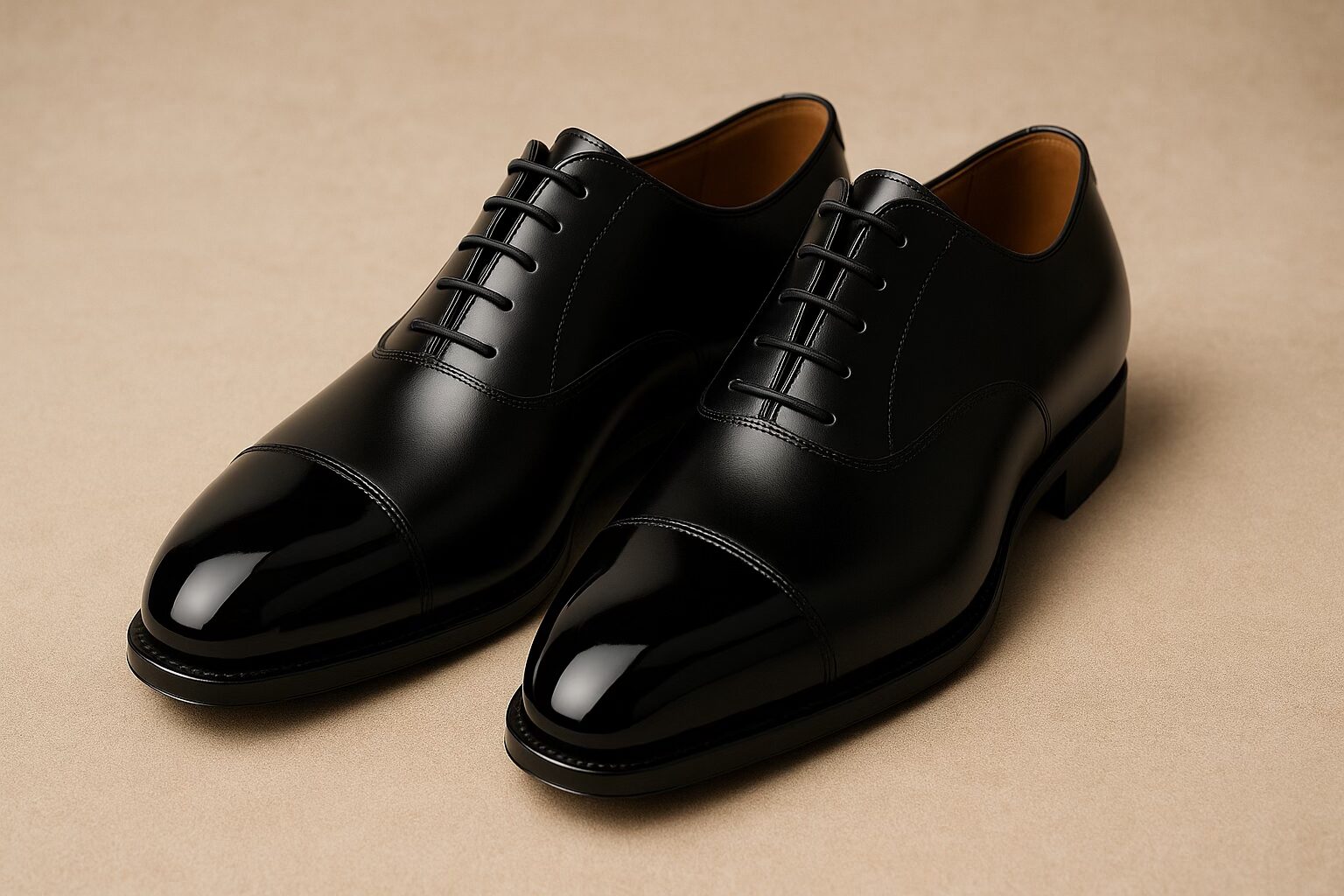
Derbies (open lacing). Popularized after General Gebhard Leberecht von Blücher adapted easy-on laced boots for troops in 1814, the style spread and settled as the Derby. Structurally more casual than Oxfords, Derbies offer easier entry and comfort for longer days.
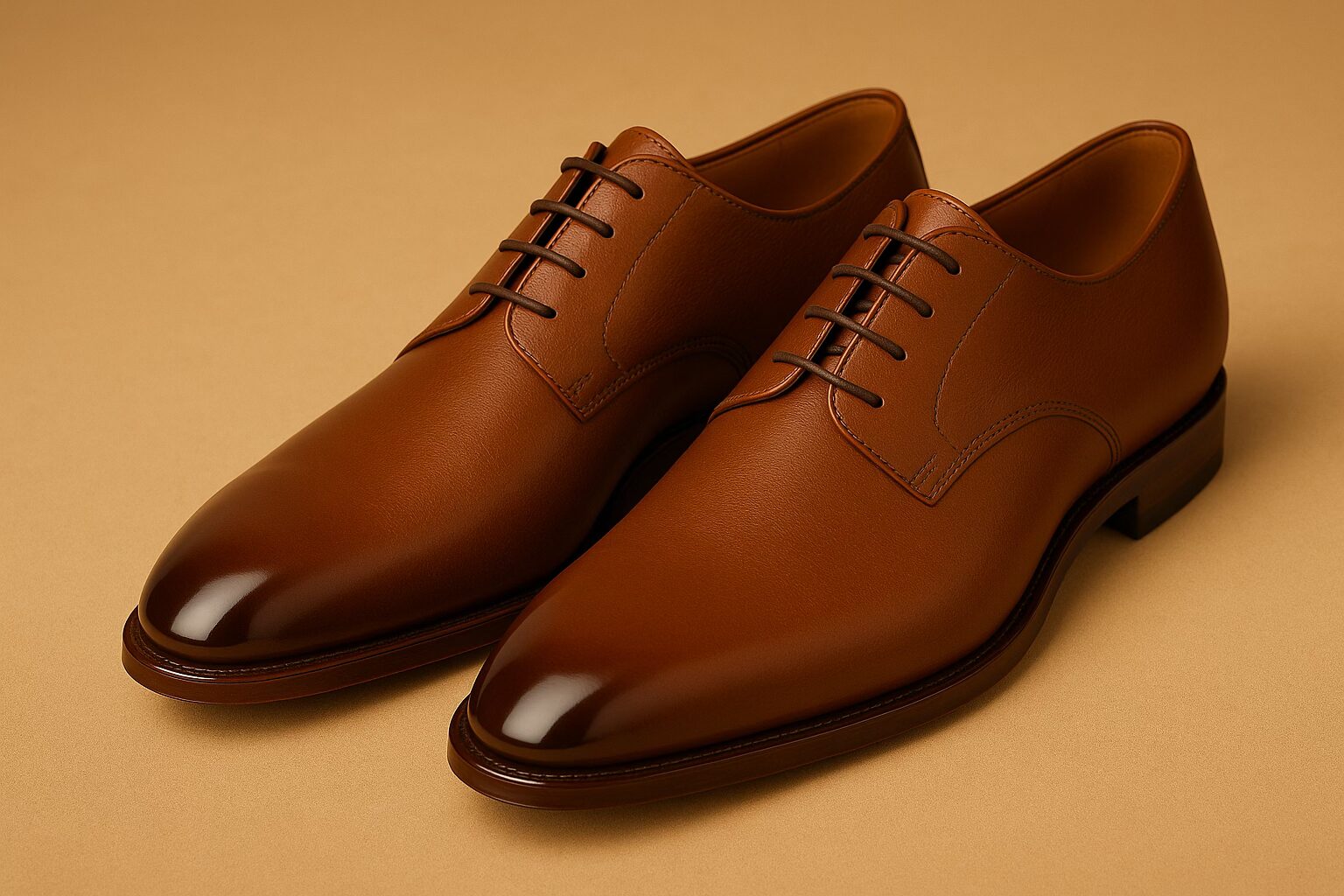
Loafers. A newer slip-on design from the early 20th century: in 1926 London’s Wildsmith devised an indoor country shoe for royalty; in the 1930s G.H. Bass popularized “Weejuns” across the U.S. Modern loafers, like the horsebit, bridge casual and business smartly.
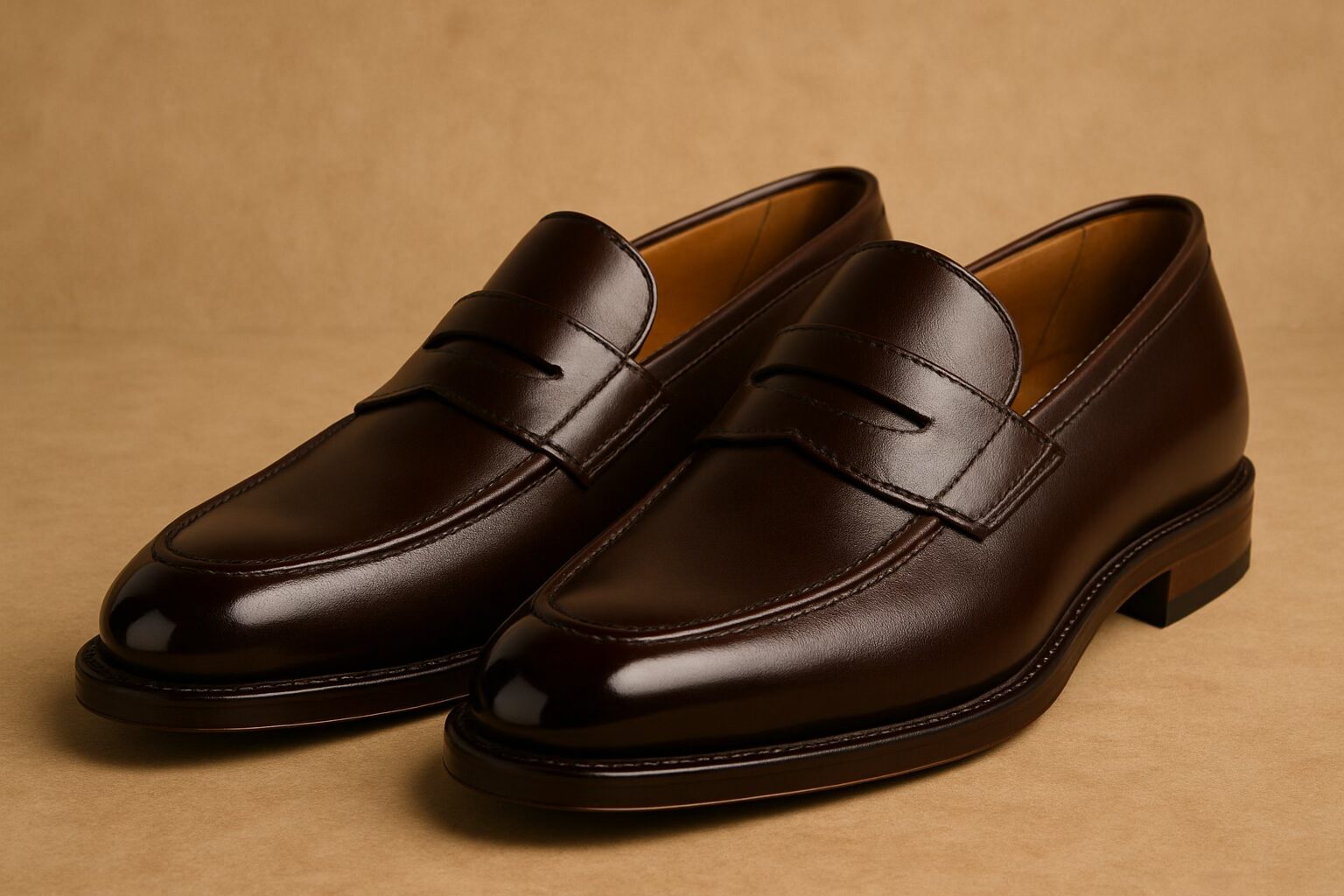
Monk straps. Rooted in monks’ leather sandals from the Alps, monks secure with a strap and buckle (single or double). They rose with tastemakers in the early 20th century and now sit between lace-ups and loafers—easy to put on, subtly decorative.
Decorative techniques and craftsmanship
Brogueing—perforation on the upper—began practically. In wet Scottish and Irish countryside, small holes drained water. Over time the pattern itself became ornament, evolving into country shoes for gentlemen and later into city wear.
Full brogue (wingtip) features a wing-shaped toe piece and richly spaced perforations. Semi-brogue uses a cap toe with brogueing along seams. Quarter brogue keeps ornament restrained for business-friendly elegance.
Executing clean brogue work demands skill: choosing hole size to suit leather, spacing and depth consistency, and stitching that elevates the shoe’s character. Japanese artisans excel at this precision, blending European tradition with meticulous finishing.
Medallions—toe-tip motifs—express geometric or floral patterns with tiny perforations. Achieving symmetry and crispness requires seasoned hands; makers’ personalities show in placement and rhythm.
Even today, much of this decoration is hand-done, giving warmth no machine can mimic. The beauty of ornament is the visible tip of deep craft skill and taste—what makes each pair singular.
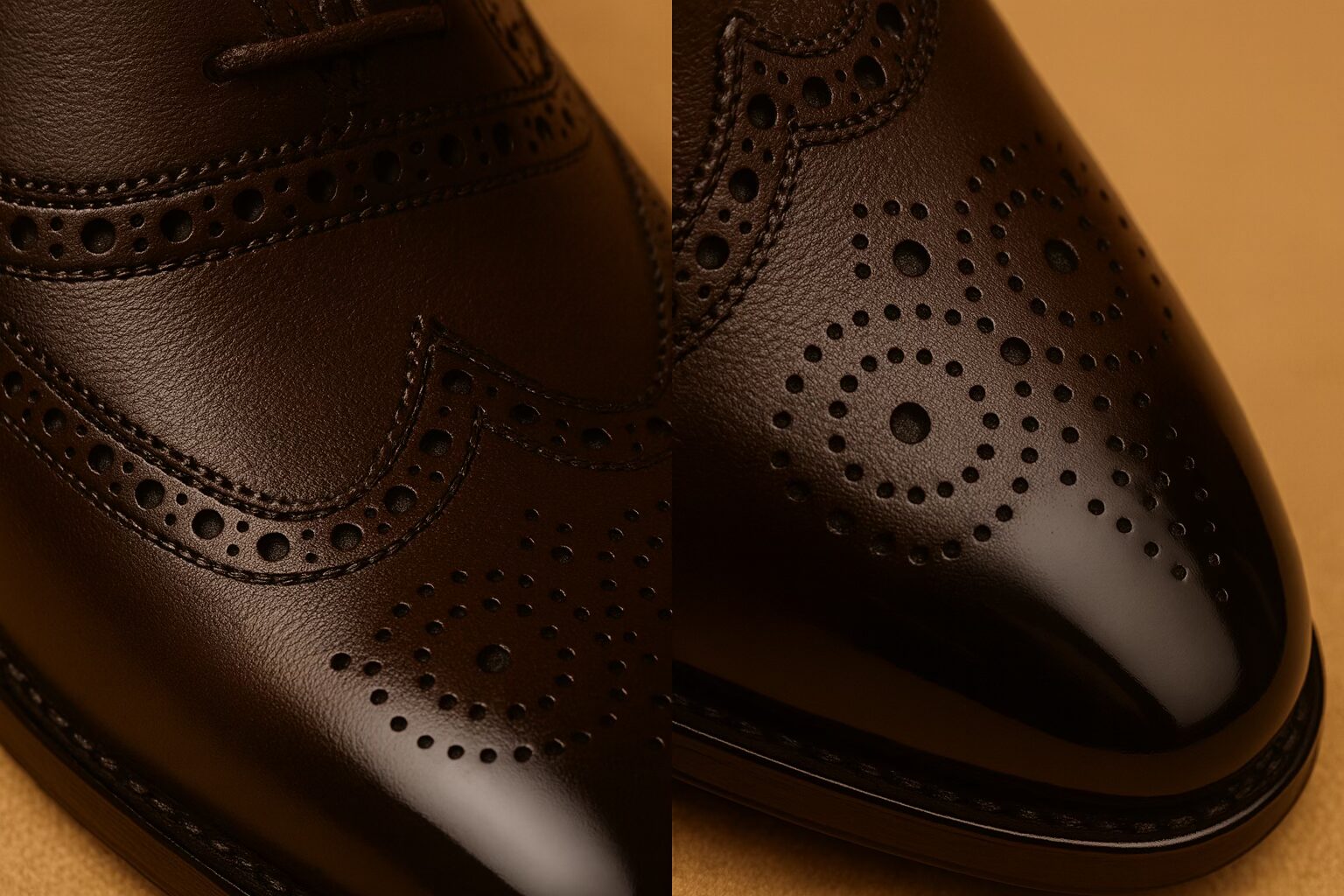
[PART 2/3]
Materials and their relationship to design
Material choice shapes both look and meaning. Type, grain, and color determine a shoe’s final character and how a design reads in context.
Calf leather—smooth and lustrous—is ideal for formal designs. On Oxfords and other dress shoes it raises the sense of refinement. Japanese-sourced calf often shows tighter fiber and subtlety, suiting nuanced finishing. Slightly thicker calf also supports decorative brogue patterns crisply.
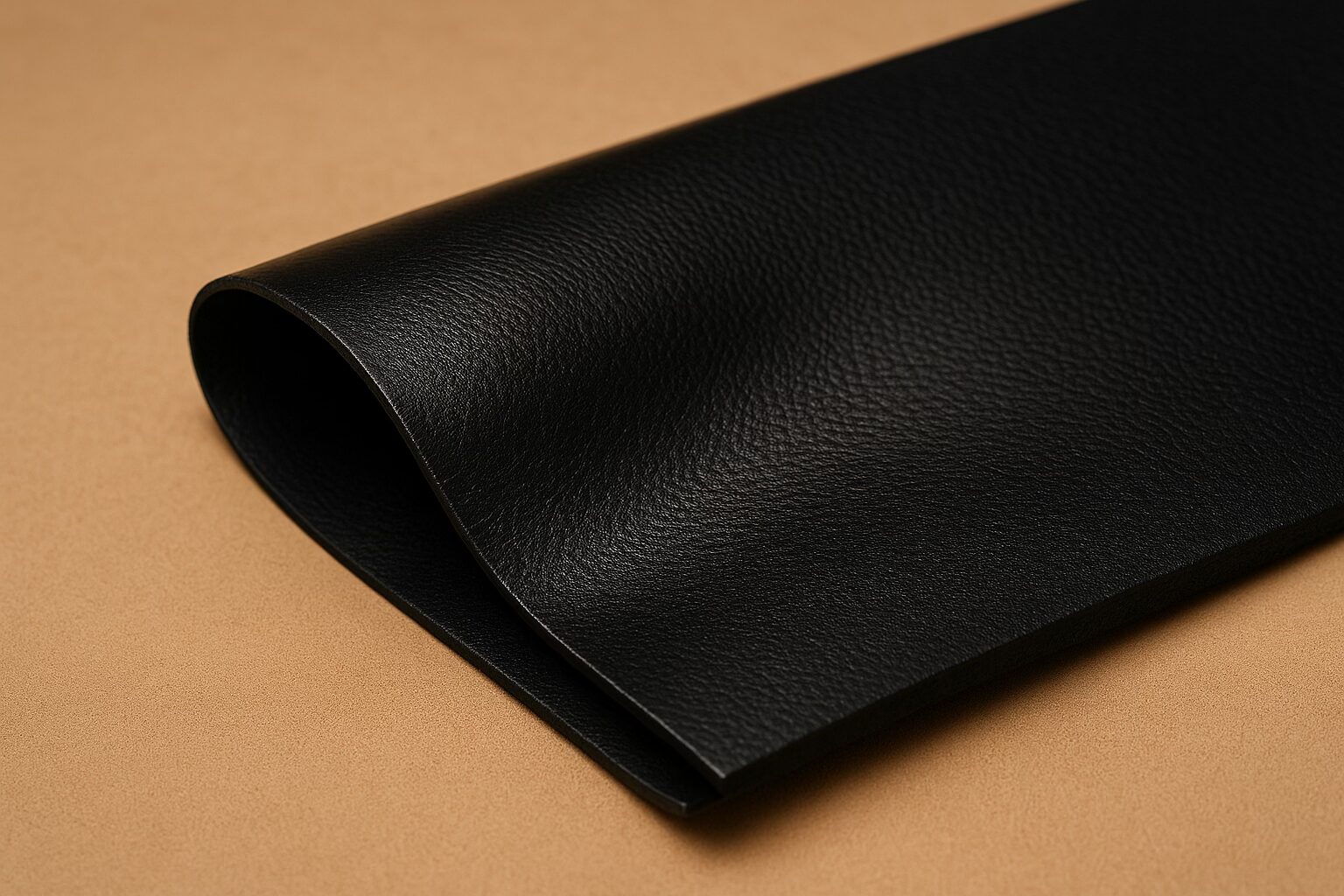
Suede brings warmth and ease, perfect for loafers and chukkas. Sand and gray suede channel British country charm updated for today. It needs mindful care, so factor maintenance into design choices.
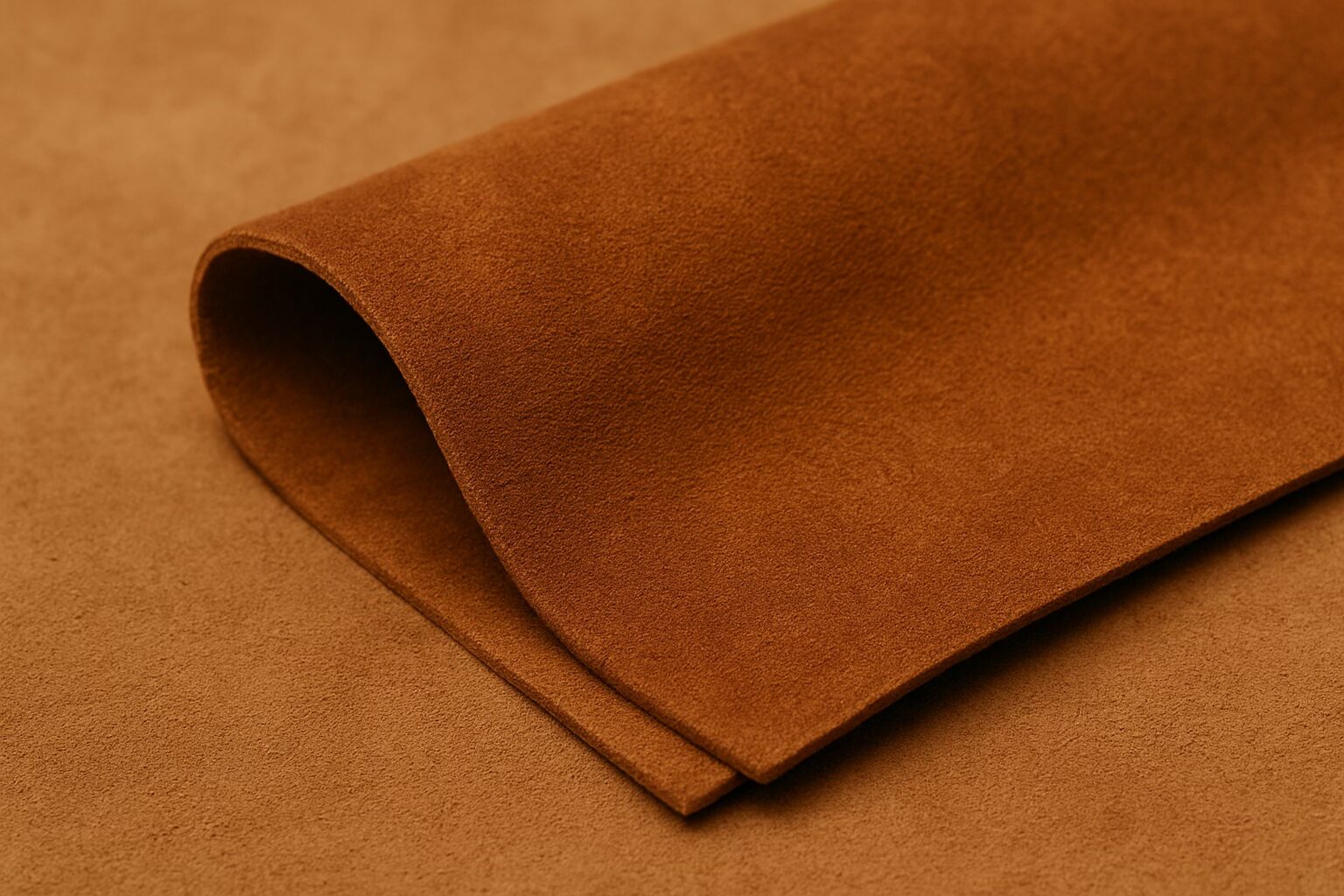
Cordovan, from a horse’s rump shell, is prized for mirror-like sheen and durability. Even plain-toe Oxfords feel elevated; with use it develops deep color. It’s costly and specialized to handle, so makers deploy it selectively.
Color strongly influences impression. Black reads most formal and versatile. Browns range from approachable light tan to dignified dark. Burgundy and navy project personality while staying refined. The craft is pairing color and design to the wearer’s needs.
Contemporary developments in design
Modern design builds on classics while answering today’s lifestyles. Makers keep the grammar of Oxfords and Derbies yet reinterpret with comfort and versatility in mind.
One trend softens formal–casual boundaries: supple uppers and cushioned soles maintain Oxford structure but walk easier at work and after. Refined lasts and premium materials give Derbies casual practicality without losing polish.
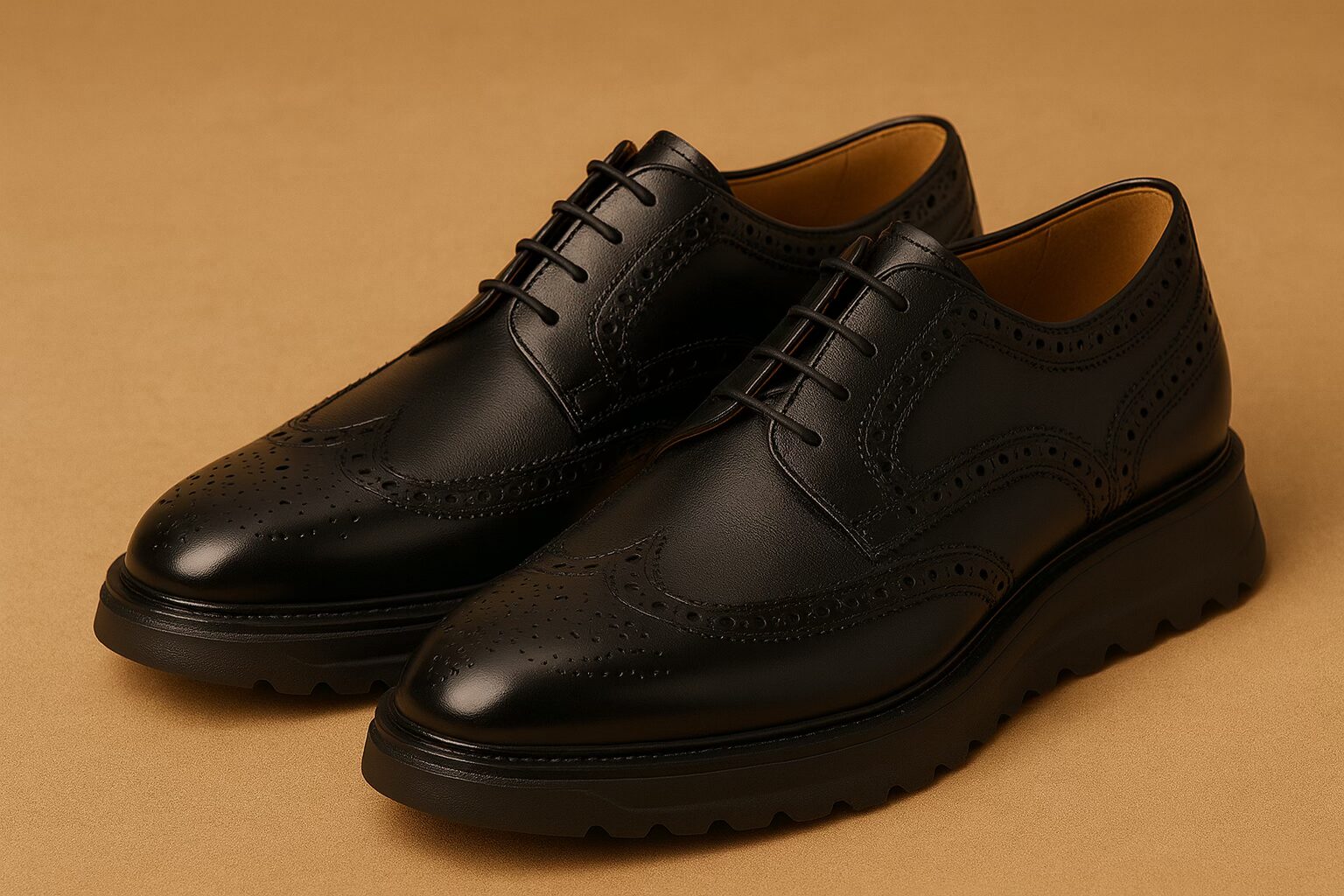
Color has broadened too. Beyond black and brown, gray, navy, and burgundy slot neatly into business-casual wardrobes, showing individuality without shouting.
Technically, makers mix constructions—Goodyear welt for durability, cemented and Blake stitch for lightness—to expand design possibilities. New adhesives and stitching enable fine details once impractical.
Sustainability matters: responsible leather sourcing, eco-friendlier tanning, and repairable structures reduce impact. Durable, timeless designs that encourage long wear align with this ethos.
Customization is growing: full bespoke from foot scans and personalized lasts, and semi-bespoke tweaks on standard models—so the shoe reflects the wearer’s life and taste.
Practical guidelines for choosing designs
Start with context and purpose—many missteps come from skipping this. Use a simple framework.
Business. In conservative fields (finance, law), black plain-toe or cap-toe Oxford shoes communicate credibility. Creative and tech environments often welcome more personality: brown brogues or monk straps can fit. Balance professionalism with self-expression.
Formal. For weddings and ceremonies, black plain-toe Oxfords are safest. Keep ornament minimal and let leather quality speak. For evening dress codes, patent opera pumps are traditional; high-quality black Oxfords are accepted today.
Casual. Weekends and dinners: loafers, chukkas, and relaxed Derbies shine. Suede and brown tones read friendly and relaxed—yet quality keeps the look grown-up.
Fit & proportions. Wider feet: open-laced Derbies and some loafers. Narrow feet: closed-laced Oxfords. High insteps benefit from adjustable lacing. Consider body proportions: taller frames can carry more volume; smaller frames often look best with cleaner silhouettes.
Budget strategy. Premium materials and craft command price, but value depends on frequency and care. Sometimes a small rotation of mid-tier pairs by use-case beats one ultra-luxe pair.
Making shoes in practice: a craft workflow
Turning design into a finished shoe involves many stages and skills. From brief to finish, makers balance quality and beauty.
Brief & last selection. We listen carefully, measure feet, and define purpose, materials, colors, and ornament. Selecting or adjusting the right last is crucial for comfort and silhouette.
Pattern making. We draft cutting patterns that protect structure while preserving lines. Decorative layouts like brogue patterns require careful alignment—new patterns can take days.
Cutting & closing. We place the most beautiful leather where it shows and match color/texture across left–right. Hand stitching, slower than machine, yields stronger, cleaner results—especially on brogue seams where even spacing and tension matter.
Lasting & bottoming. We pull the upper over the last and fix it, the finesse here defining comfort and shape. Japanese makers often tune fine adjustments for fit. For Goodyear welt, we sew the welt to upper and insole, then stitch the outsole—work that demands seasoned hands.
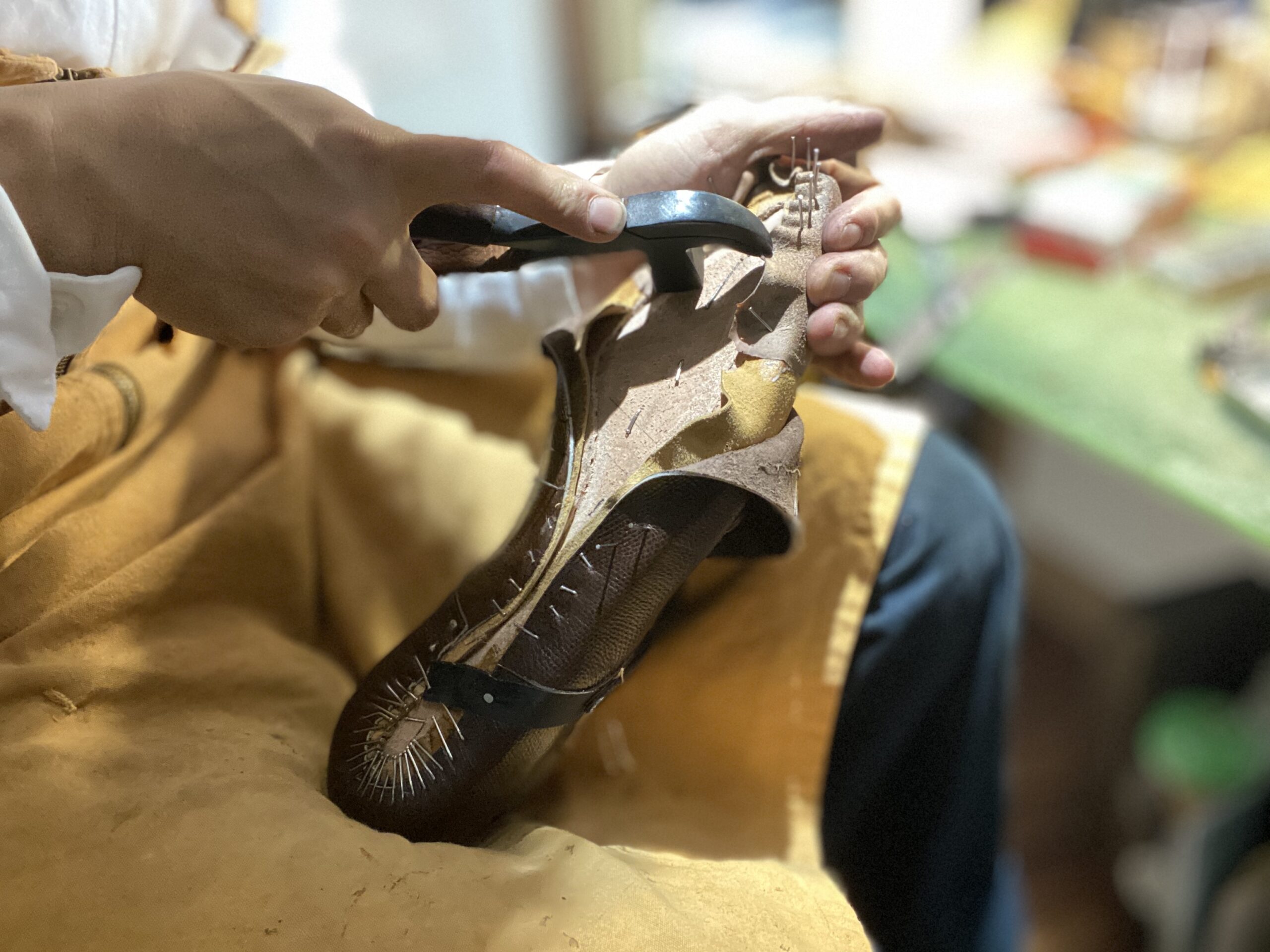
Finishing. We shape, clean, and polish to reveal intended lines, then condition and wax to bring out the leather’s depth. Details like seam cleanup and edge finishing matter—what you don’t see counts too.
Maintenance and design: how care shapes longevity
Keeping a design beautiful over years requires the right care. Methods vary by design and leather.
Smooth calf Oxfords/Derbies. Wipe dust after wear, deep-clean weekly, and match cream to color. For cap-toe and plain toes, a brighter toe mirror elevates the whole shoe.
Brogues. Perforations trap dirt and moisture—use a small brush and consider water-resistant creams. Overlap seams can dry out; moisturize regularly and polish without clogging patterns.
Suede. Avoid creams. Brush to lift nap and spot-clean with suede products after testing for colorfastness.
Slip-ons & monks. Inspect heel cups and straps where stress concentrates; repair early. Always use shoe trees to maintain shape.
Repairability. Goodyear-welted shoes usually accept resoling for decades; cemented pairs are often less economical to repair. Set expectations so beauty can last with practical care.
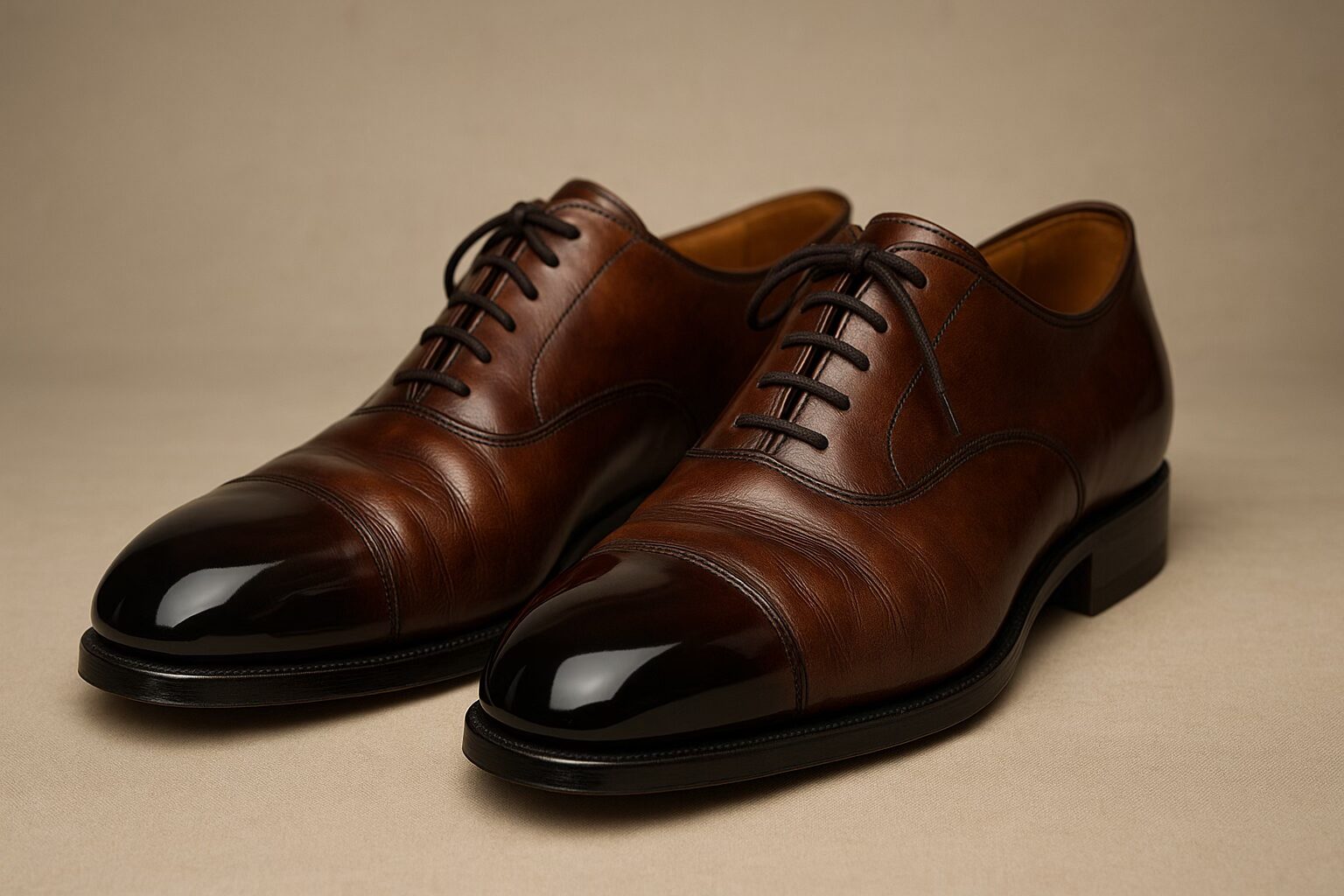
[PART 3/3]
Pitfalls when choosing designs
Common traps are avoidable with a little knowledge. Price alone doesn’t equal value; match the shoe to needs and care habits. Trend-chasing can backfire—dress shoes reward timeless function and proportion.
Sizing myths persist: don’t buy too tight “to stretch” or overly large to pad with insoles. Proper size should feel right from day one—get measured and seek expert advice.
Know context: brogues began as country shoes and are less formal; well-chosen brown leather works in many business settings today. Understanding history and modern norms prevents mismatches.
Finally, never neglect maintenance. Even the best design loses its charm without care.
Judging quality and design together
Assess beyond surface beauty. Evaluate leather quality (natural luster, resilient hand, subtle variation), stitching (even spacing, steady tension), and joins (no gaps or steps).
Check soles and attachment: on Goodyear welt pairs, look for balanced welt stitching and clean outsole joins; on leather soles, inspect finish; on rubber, the bond and edge treatment.
Design completion shows in balance from every angle: toe shape, side line flow, heel height and rake. Hardware should suit the whole. Japanese makers often shine in these quiet details.
Price should reflect real material and process quality. Extremely cheap shoes often hide shortcuts; very expensive pairs may carry brand premiums. Buy from makers or retailers who can explain materials, construction, and aftercare.
The future of shoe design and the artisan’s role
We balance heritage with innovation. Digital tools (3D scanning/printing) enable precise lasts and efficient customization; new materials broaden function. Yet craft experience remains the compass.
Sustainability is essential: responsible sourcing, lower-impact tanning, recyclable components, and structures that invite repair align with the Japanese spirit of mottainai.
Lifestyle shifts blur categories—remote work and wellness raise comfort’s priority. Makers reinterpret classics to suit modern rhythms.
Artisans now build, advise, teach, and transmit culture. We must understand individual needs, mentor the next generation, and share Japan’s craft with the world.
Future design will grow through both globalization and individuality—learning widely while creating distinctly Japanese expressions.
Closing thoughts
Shoes are partners in life. Choose designs that suit you, then care for them; their character deepens with time.
Know yourself—lifestyle, values, body, feet—and take time to seek advice from trusted experts.
Make maintenance routine: clean, condition, use shoe trees—these are conversations with your shoes that build understanding and attachment.
Share the cultural value of dress shoes with others; knowledge enriches appreciation and helps tradition endure.
Good shoes bring confidence and joy in motion—at work, in formality, and at ease. May this guide help you find the pair that becomes a true companion.
Sponsorship Information
“The Makers Guild” is an international community site that shares craft and shoe culture. We are currently welcoming sponsorships from partners who support our mission.
